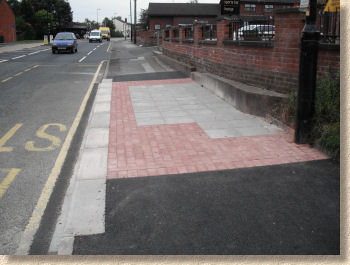Tameside trial alternative sand
Construction aggregates have changed radically over recent years and most of us are familiar with type 1 or type 2 material being formulated from recycled material, usually concrete, and there's even a provision in the latest SHW to use those bloody awful road planings, but to give them a fancy name, asphalt arisings, and designate them as Type 4. In the aggregate-poor SE of England, they've been playing with alternatives to 'sharp' sand primarily used as a laying course material for pavements construction, but there's not been much interest, other than the purely academic, outside that benighted corner of the country.
However, as Local Authorities have been charged with sending less of our disposable society's disposings to landfill, methods of re-using or recycling even the most mundane of materials are being more carefully considered for their potential.
Tameside, one of the ten boroughs annexed to form Greater Manchester, has a dedicated reclamation centre at its Ash Road facility in Droylsden, a site which is home to a glass crusher. Basically, the empty glass bottles provided by the good burghers of Tameside are crushed, the unwanted lids, caps, labels and ring-pulls are spat out, and a clever centrifuge and sieve system sorts the particles according to size, sending each of the nominated sizes to a designated bin.
But what to do with all that glass once it's been crushed?
The actual sizes can be fettled to suit requirements, and it just so happens that the Highways Team based at Stalybridge recognised that a 8mm down grain size might have potential as a laying course sand, and the 1.2mm stuff might be suitable for use as a jointing material.
The proof of the pudding is in the eating, or so they say, so the only way to test the suitability of the reclaimed glass aggregate was to build a pavement.
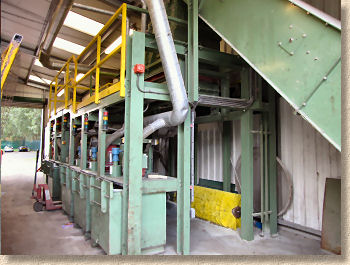
Obviously, when trialling a new laying course material, you don't want to re-pave the entire town centre only to discover in 6 months time that the stuff turns to dust, the paving drops, and the whole lot has to be lifted and re-laid, at massive expense and to the disgruntlement of the local community. What you want are small test areas that offer simple installation and can be monitored over a period of months or years to evaluate the performance against other, similar small areas that have been laid using 'conventional' materials.
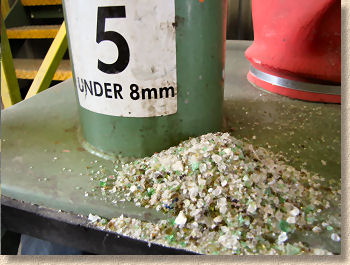
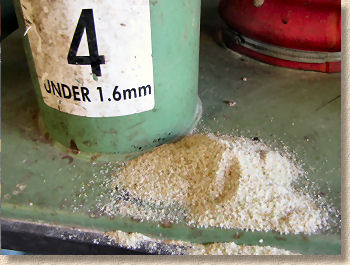
As luck would have it, Tameside Highways are in the midst of a bus stop improvement programme, part of the Quality Bus Corridor scheme whereby the prime routes through the borough are having their bus stops upgraded with the latest signage and pedestrian-friendly access features, which involves re-paving. With each bus-stop offering around 10 square metres of paving, these could be the ideal test panels.
And so the upgraded bus stop outside the Queen's Arms on Guide Lane in Audenshaw was selected to be the first trial panel. The Kassel kerbs were already in place, and the paving would comprises a 400mm band of 80mm red CBPs at the back of the kerb with E70 pressed concrete flags forming the bulk of the panel. The sub-base had been prepared, and a team, including several of the borough's much-admired apprentice paviors, brought in to lay the paving.
Step one was to spread and level the greenish-hued crushed glass laying course material, this was done in the same way as would be used for a conventional sand laying course, even down to screeding. It was noticed that the recycled glass material was much dustier than sand. Operatives were required to wear masks and a decision was taken to lay half the area using dry aggregate and to complete the panel using material that had been wetted with clean water. This significantly reduced the dust, and the operatives reported that they found it easier to screed the material when it was damp, and that it was less prone to becoming lodged behind their knee pads.
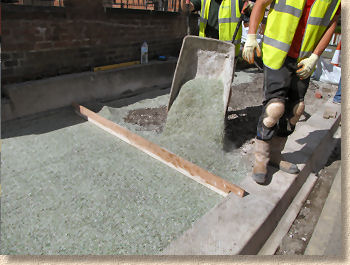
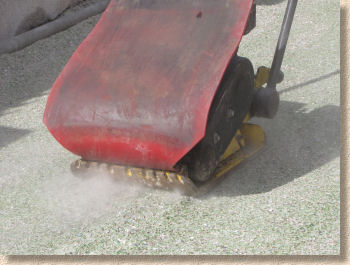
When it came to compaction, the vibrating plate threw up clouds of potentially dangerous dust from the dry material, but almost no visible dust with the wetted version. And again, the operative reported that the wetted material seemed to compact better and more like they were accustomed to with conventional sand. Even so, it was noticeable that there was significantly less compaction than might be expected with sand. A 50mm layer of crushed glass compacted down by on 5-7mm on average where we might have expected 10-14mm with a sand.
Once screeded, the laying course presented no discernible problems to placing the paving elements, either the blocks or the flags. Once all the pavings were laid, the two ends were temporarily restrained and the afternoon's second guest aggregate was introduced as a jointing medium.
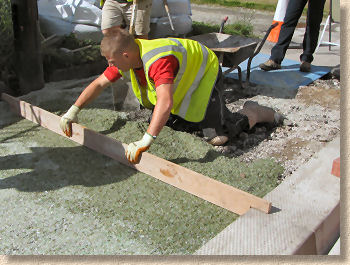

Somewhere around 15kg of the 1.6mm crushed sand was used to joint the trial panel, and it was noted that the material did not 'flow' into the joints in the way that a normal kiln-dried sand might. Even after covering the whole 10m², there was surplus material and it was apparent that many joints were still partially empty. However, the grain size was such that no further material could be persuaded into the joints, so it was decided to compact the paving and see if the crushed glass settled into the joints. The material remaining on the surface was swept off.
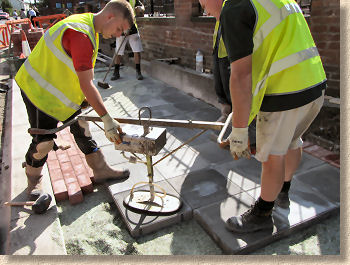
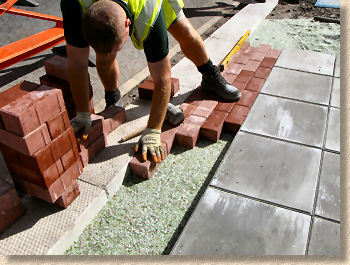
Using a smaller-than-normal vibrating plate compactor fitted with a sole plate to avoid damage to the pavings, settlement of the paving elements was less than might be expected with a conventional sand laying course, with the paving elements going down by 2-5mm on average, just sufficient to even out the thickness discrepancies between adjacent elements. And while the jointing did settle, subsequent attempts at topping-up with more of the same material had limited success.
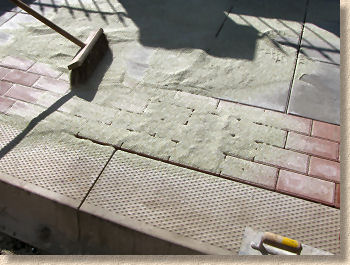
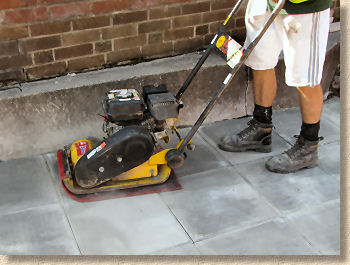
Obviously, the panel will be monitored over the coming months to assess its performance, but early lessons from the trial would indicate that there is genuine potential for the “Tameside Technique” . Work is required to ensure the crushed glass has an adequate grading envelope, but there is a sense that this may require nothing more than a bit of judicious blending of the various grades of crushed material. And it will be essential, if only from a Health and Safety perspective, for the laying course material to be wetted prior to use. This represents more of a problem, as glass that has been wetted prior to crushing causes sizing problems within the crusher, so post-crushing addition of water would seem to be the only option at this stage, but when, and how much?
As for jointing material, this, plainly, cannot be wetted, but there was a broad agreement that the current grading envelope is too coarse and it may require careful addition of finer, 0.4mm material to achieve a jointing material that flow and fills the joints.
While this is just one panel, in one town, it is significant in that it shows local authorities are now beginning to look for their own, local answers to the re-use of reclaimed materials and the upgrading of the local pavements. The Tameside Technique is a valuable model, and one that will be followed-up by pavingexpert.com to assess its true potential.
